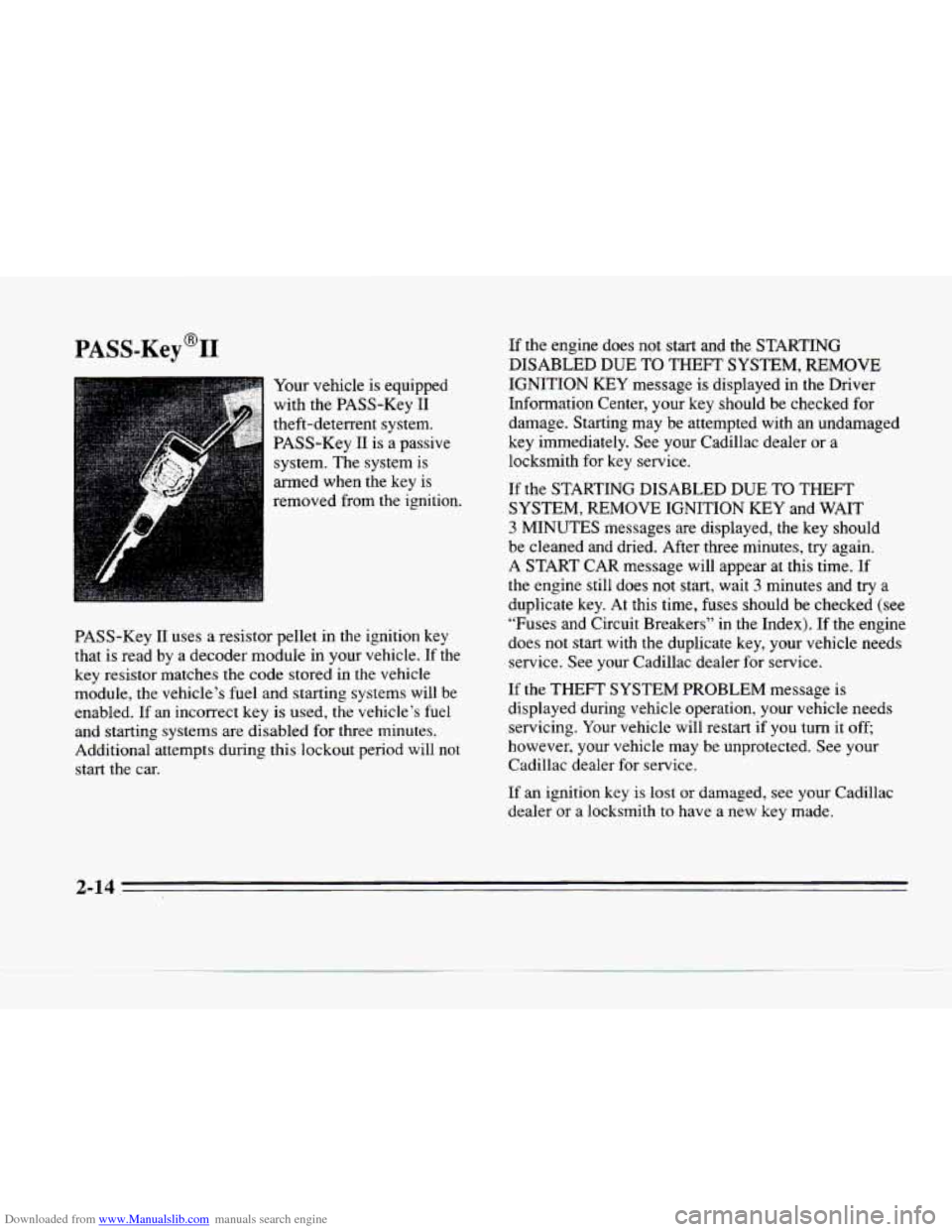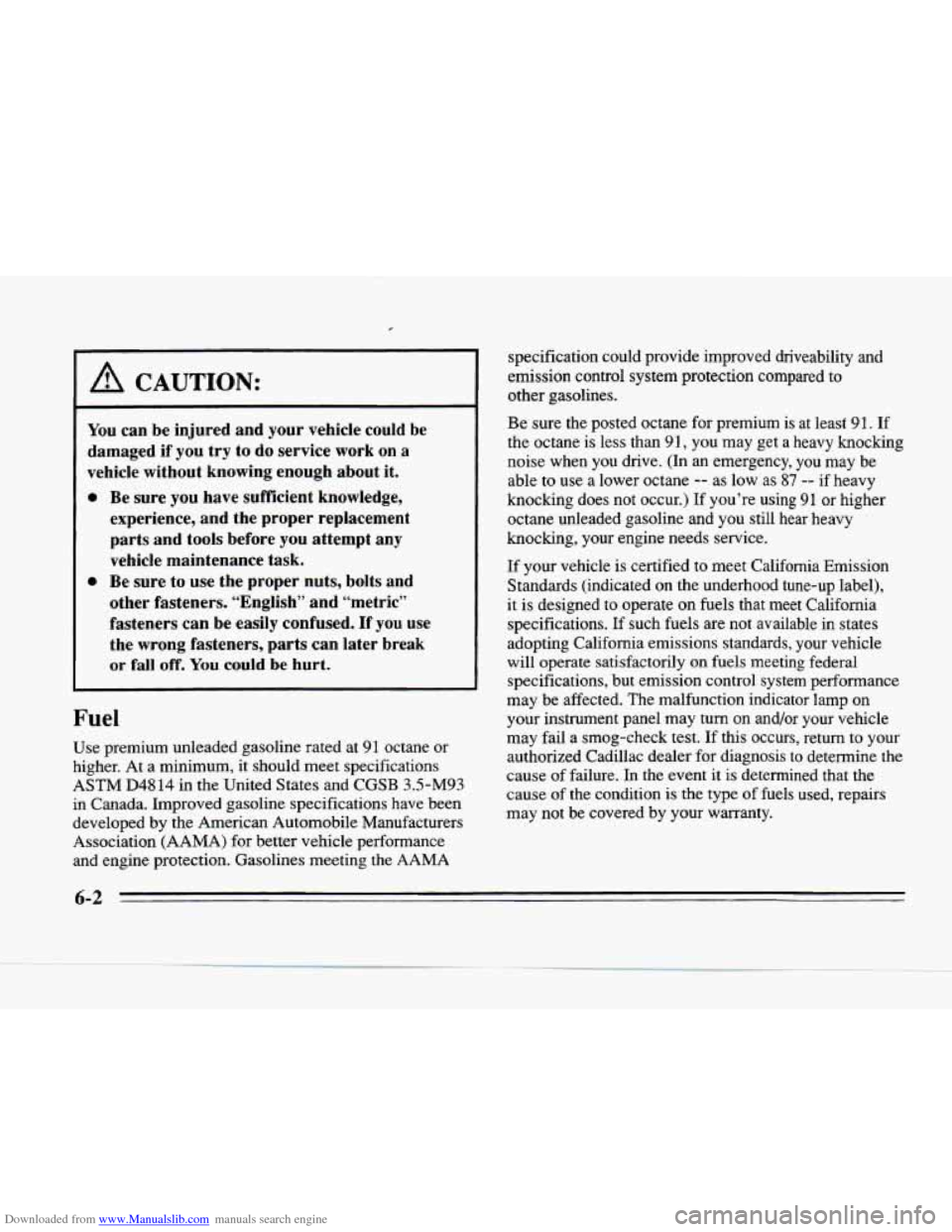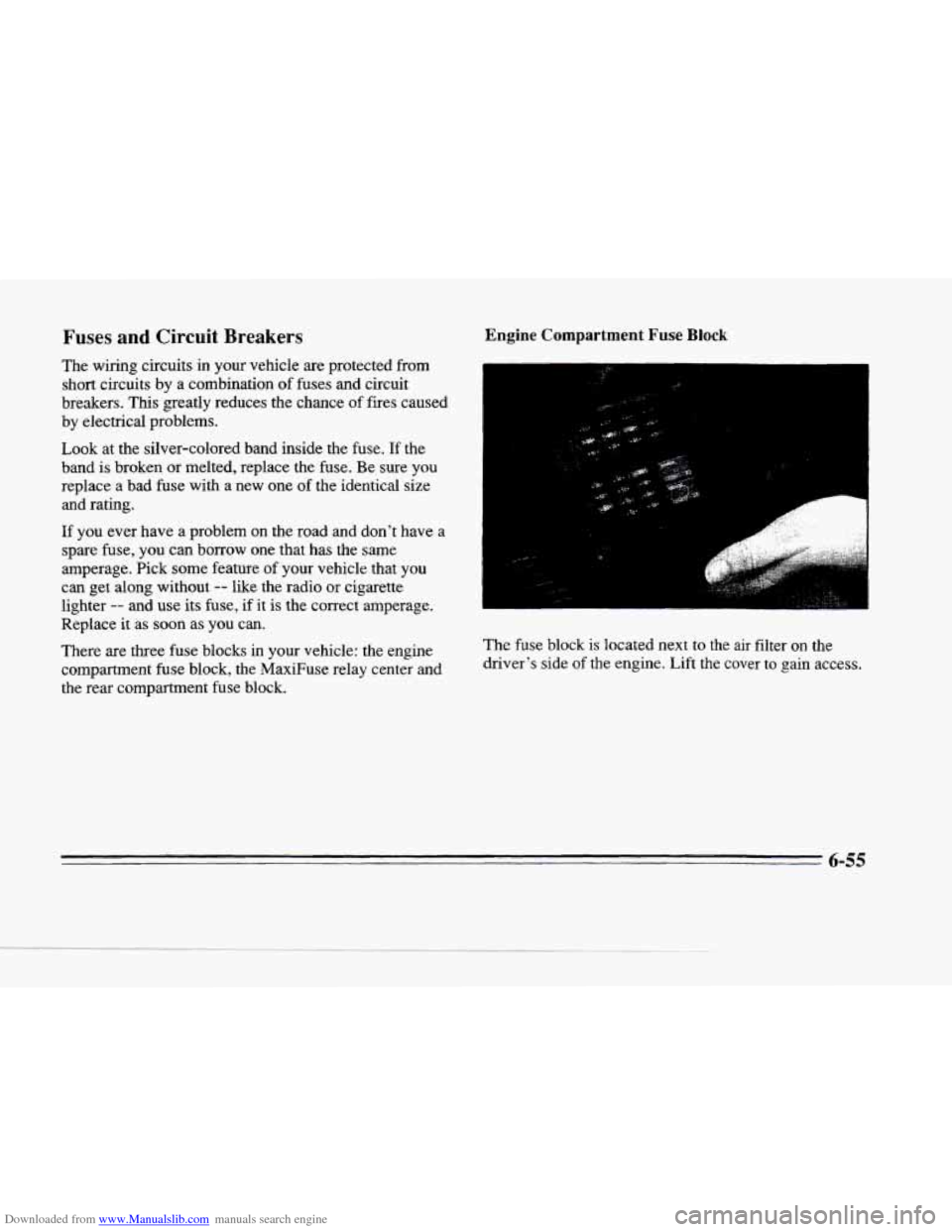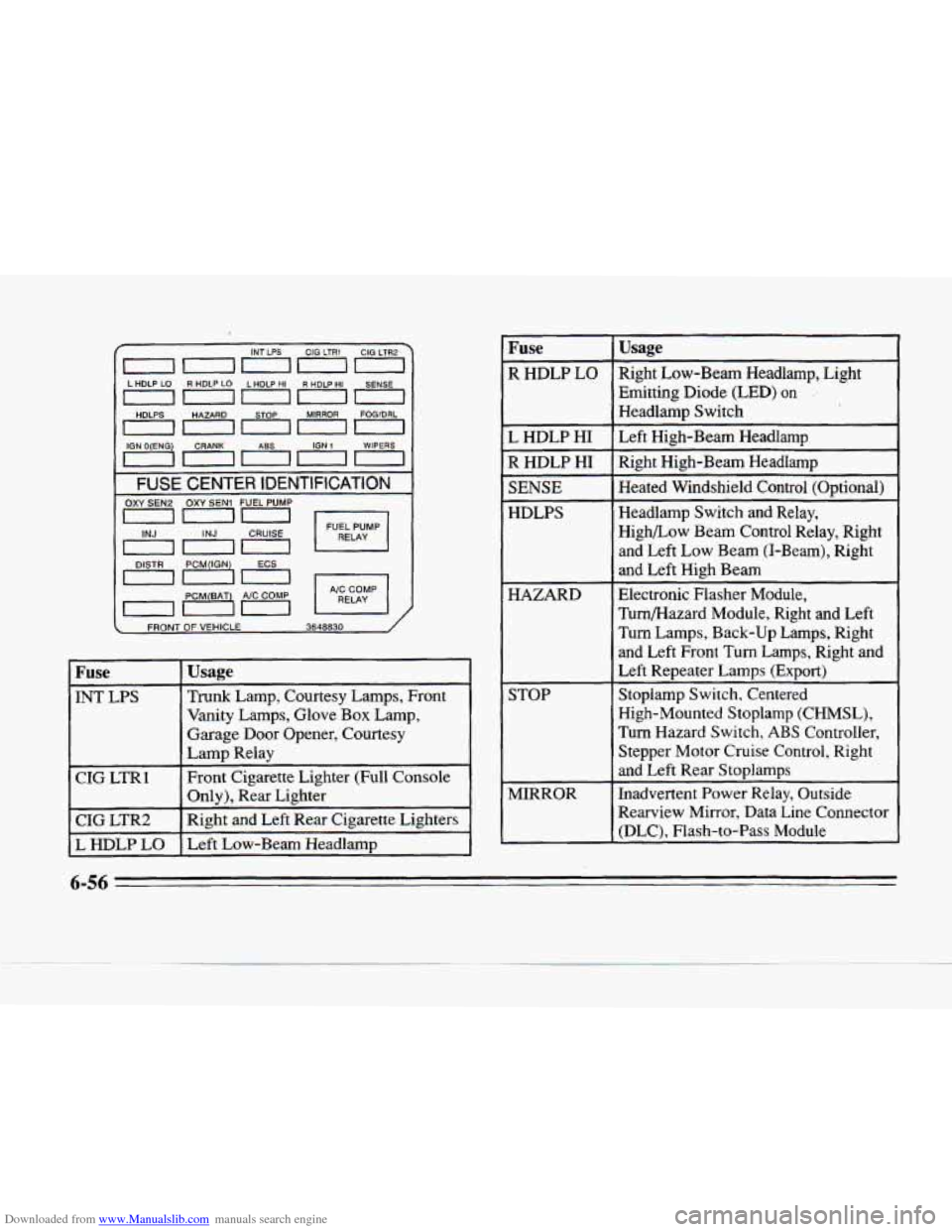1996 CADILLAC SEVILLE fuse
[x] Cancel search: fusePage 14 of 354

Downloaded from www.Manualslib.com manuals search engine e
e
c
Vehicle Symbols
These are some of the symbols you will find on your vehicle.
For example,
these symbols
are used
on an
original battery:
POSSIBLE A
CAUTION
INJURY
PROTECT
EYES BY
SHIELDING
CAUSTIC
BURNS AVOID
SPARKS
OR
FLAMES
SPARK
OR ,111,
COULD FLAME
EXPLODE BAllERY
These symbols
are important
for you and
your passengers
whenever your
vehicle
is
driven:
DOOR LOCK
UNLOCK
FASTEN SEAT
BELTS
POWER
WINDOW
These symbols have
to do with
your lights:
SIGNALS e
TURN
RUNNING
0
DAYTIME -
LAMPS -**
FOG LAMPS # 0
These symbols are on
some of
your controls:
WINDSHIELD
WIPER
WINDSHIELD DEFROSTER
WINDOW
DEFOGGER
VENTILATING FAN
These symbols
are used on
warning and
indicator lights:
COOLANT -
TEMP -
CHARGING I-1
BATTERY
SYSTEM
BRAKE
(a)
COOLANT a
ENGINE OIL w,
PRESSURE
ANTI-LOCK
(,)
BRAKES
Here are some
other symbols
you may see:
FUSE
LlGl ITER D
HORN k3
SPEAKER
k
FUEL B
xiii
Page 72 of 354

Downloaded from www.Manualslib.com manuals search engine F
c
Remember, the theft-deterrent system won’t activate if
you lock the doors with a key or use the manual door
lock. It activates only if you use a power door lock
switch or the Keyless Entry system.
To avoid activating the alarm by accident:
0 The vehicle should be locked with the door key after-
the doors are closed if you don’t want to activate the
theft-deterrent system.
Always unlock a door with a key or use the Keyless
Entry system. (Pressing the unlock button on the
Keyless Entry transmitter disables the theft-deterrent
system.) Unlocking a door any other way will
activate the alarm. Cycling the ignition without
disarming the theft-deterrent system will also
activate the alarm.
If you activate the alarm by accident, unlock any door
with your key.
You can also turn off the alarm by using
the Keyless Entry system. The alarm won’t stop if you
try to unlock a door any other way.
Testing the Alarm
1. From inside the vehicle, roll down the window, then
get out of the vehicle, keeping the door open.
2. From outside of the vehicle, with the door open, lock
the vehicle using the power door lock or the Keyless
Entry
system and close the door. Wait 30 seconds.
3. Reach in and unlock the door using the manual lock
and open the door. The horn will sound and the
headlamps will flash.
If the alarm does not sound when it should, check to
see if the horn works. The
horn fuse may be blown. To
replace the fuse, see “Fuses and Circuit Breakers” in
the Index. If the fuse does not need to be replaced, you
may need to have your Cadillac serviced.
To reduce the possibility of theft, always activate
the optional theft-deterrent system when leaving
your vehicle.
Page 73 of 354

Downloaded from www.Manualslib.com manuals search engine PASS-Key@II
Your vehicle is equipped
with the PASS-Key I1
theft-deterrent system. PASS-Key I1 is a passive
system. The system is
armed when the key is
removed from the ignition.
PASS-Key
I1 uses a resistor pellet in the ignition key
that
is read by a decoder module in your vehicle. If the
key resistor matches the code stored in the vehicle
module, the vehicle’s fuel and starting systems
will be
enabled.
If an incorrect key is used, the vehicle’s fuel
and starting systems are disabled
for three minutes.
Additional attempts during this lockout period will not
start the car. -If
the engine does not start and the STARTING
DISABLED
DUE TO THEFT SYSTEM, REMOVE
IGNITION KEY message is displayed in the Driver
Information Center, your key should be checked for
damage. Starting may
be attempted with an undamaged
key immediately. See your Cadillac dealer or a
locksmith for key service.
If the STARTING DISABLED DUE TO THEFT
SYSTEM, REMOVE
IGNITION KEY and WAIT
3 MINUTES messages are displayed, the key should
be cleaned and dried. After three minutes, try again.
A START CAR message will appear at this time.
If
the engine still does not start, wait 3 minutes and try a
duplicate key. At this time, fuses should be checked (see
“Fuses and Circuit Breakers” in the Index). If the engine
does not start with the duplicate key, your vehicle needs
service. See your Cadillac dealer
for service.
If the THEFT SYSTEM PROBLEM message is
displayed during vehicle operation, your vehicle needs servicing. Your vehicle will restart
if you turn it off;
however, your vehicle may be unprotected. See your
Cadillac dealer for service.
If an ignition key is lost or damaged, see your Cadillac
dealer or a locksmith
to have a new key made.
2-14
Page 92 of 354

Downloaded from www.Manualslib.com manuals search engine rrr
xz
e
If the turn signal is left on, a warning chime will sound
and the
DIC will display TURN SIGNAL ON (after
driving about a mile) to remind you to turn it off.
Arrows that
flash rapidly when signaling for a turn or
lane change may be caused by
a burned out signal bulb.
Other drivers won’t see the turn signal.
Replace burned
out bulbs to help avoid possible
accidents. Check the fuse (see “Fuses and Circuit
Breakers”
in the Index) and for burned-out bulbs if the
arrow fails
to work when signaling a turn.
Headlamp High/Low Beam
Pull the turn signal lever all
the way toward you and
then release
it to change the
headlamps from low beam
to high or from high beam
to low. The blue light on the
instrument panel will be on
indicating high-beam usage.
Flash-To-Pass
This lets you use the high-beam headlamps to signal the
driver in front
of you that you want to pass. It works
even if
the headlamps are off.
Pull the turn signal lever toward you to use. When you do:
0 If the headlamps are off, the high-beam headlamps
will turn on. They’ll stay on as
long as you hold the
lever there. Release the lever to turn them off.
If the headlamps are on low beam, they will shift to
high beam and stay there. Pull
the lever toward you
to return to low beam.
0 If the headlamps are on high beam, they will switch
to low beam. To return to high beam, pull the lever
toward
you.
2-33
Page 261 of 354

Downloaded from www.Manualslib.com manuals search engine ,
I--- ~
I A CAUTION:
You can be injured and your vehicle could be
damaged if you try to do service work on a
vehicle without knowing enough about it.
~ 0 Be sure you have sufficient knowledge,
experience, and the proper replacement
parts and tools before
you attempt any
vehicle maintenance task.
0 Be sure to use the proper nuts, bolts and
other fasteners. “English” and “metric”
fasteners can be easily confused. If you
use
the wrong fasteners, parts can later break
or fall off. You could be hurt.
Fuel
Use premium unleaded gasoline rated at 91 octane or
higher. At a minimum,
it should meet specifications
ASTM D4814 in the United States and CGSB 3.5-M93
in Canada. Improved gasoline specifications have been
developed by the American Automobile Manufacturers
Association (AAMA) for better vehicle performance
and engine protection. Gasolines meeting the AAMA
specification could provide improved driveability and
emission control system protection compared to
other gasolines.
Be sure the posted octane for premium is at leasf
9 1. If
the octane is less than 91, you may get a heavy knocking
noise when you drive. (In an emergency, you may be
able to use
a lower octane -- as low as 87 -- if heavy
knocking does not occur.) If you’re
using 91 or higher
octane unleaded gasoline and you still hear heavy
knocking, your engine needs service.
If your vehicle is certified to meet California Emission
Standards (indicated on the underhood tune-up label),
it is designed to operate on fuels that meet California
specifications. If such fuels are not available
in states
adopting California emissions standards, your vehicle
will operate satisfactorily
on fuels meeting federal
specifications, but emission control system performance
may be affected. The malfunction indicator lamp on
your instrument panel may turn on and/or your vehicle
may fail a smog-check
test. If this occurs, return to your
authorized Cadillac dealer for diagnosis to determine the
cause of failure. In the event it
is determined that the
cause
of the condition is the type of fuels used, repairs
may not be covered by your warranty.
6-2
Page 313 of 354

Downloaded from www.Manualslib.com manuals search engine Electrical System
Add-on Electrical Equipment
NOTICE:
Don’t add anything electrical to your Cadillac
unless you check with your dealer first. Some
electrical equipment can damage your vehicle
and the damage wouldn’t be covered by your
warranty. Some add-on electrical equipment
can keep other components from working as
they should.
Your vehicle has an air bag system. Before attempting to
add anything electrical
to your Cadillac, see “Servicing
Your
Air Bag-Equipped Cadillac” in the Index.
Headlamp Wiring
The headlamp wiring has an individual fuse which is
powered by
a MaxiFuse@. An electrical overload will .
cause the lamps to go on and off, or in some cases to
remain
off. If this happens, have the headlamp wiring
checked right away.
MaxiFuse is
a registered trademark of Little
Fuse Incorporated.
Windshield Wiper Fuses
The windshield wiper motor is powered by a MaxiFuse.
If the motor overheats due to heavy snow, etc., the wipers
will stop until the motor cools. If the overload is caused
by some electrical problem, be sure to have it fixed.
Power Windows and Other Power Options
Circuit breakers protect the power windows and other
power accessories. When the current load
is too heavy,
the circuit breaker opens and closes, protecting the
circuit until the problem is fixed or
goes away.
6-54
Page 314 of 354

Downloaded from www.Manualslib.com manuals search engine c
r".
Fuses and Circuit Breakers
The wiring circuits in your vehicle are protected from
short circuits by a combination
of fuses and circuit
breakers. This greatly reduces the chance of fires caused
by electrical problems.
Look at the silver-colored band inside the fuse. If the
band is broken or melted, replace the fuse. Be sure you
replace
a bad fuse with a new one of the identical size
and rating.
If you ever have a problem on the road and don't have a
spare fuse, you can borrow one that has the same
amperage. Pick some feature of your vehicle that you
can get along without
-- like the radio or cigarette
lighter
-- and use its fuse, if it is the correct amperage.
Replace
it as soon as you can.
There
are three fuse blocks in your vehicle: the engine
compartment fuse block, the MaxiFuse relay center and
the rear compartment fuse block.
hgine Compartment Fuse Block
r-
The fuse block is located next to the air filter on the
driver's side
of the engine. Lift the cover to gain access.
6-55
Page 315 of 354

Downloaded from www.Manualslib.com manuals search engine , , , I I INT LPS I , CIG LTRI , , CIG LTR2 I
00~00
L HDLP LO R HDLP LO L HDLP HI R HDLP HI . SENSE
, HDLPS I , HAZARD , , STOP I , MIRROR I F0(3/DRL ,
IGN O(ENG) CRANK WIPERS
FUSE CENTER IDENTIFICATION
OXY SEN2 OXY SEN1 FUEL PUMP
CRUISE RELAY
, DlSTR ,PC~JI(IGN)~ I ECS ,
, , ,PCM(BAT), IA/C COM?
L FRONT OF VEHICLE 36488x1
I Fuse
INT LPS
E
CIG LTR2
L HDLP LO
Usage
Trunk Lamp, Courtesy Lamps, Front
Vanity Lamps, Glove
Box Lamp,
Garage Door Opener, Courtesy
Lamp Relay
Front Cigarette Lighter (Full Console
Only), Rear Lighter
Right and Left Rear Cigarette Lighters
Left Low-Beam Weadlamp
Fuse
R HDLP LO
LDLP HI
R HDLP HI
SENSE
HDLPS
HAZARD
STOP
MIRROR
Usage
Right Low-Beam Headlamp, Light Emitting Diode
(LED) on -.
Headlamp Switch
Left High-Beam Headlamp
Right High-Beam Headlamp
Heated Windshield Control (Optional)
Headlamp Switch and Relay,
High/Low Beam Control Relay, Right
and Left Low Beam (I-Beam), Right
and Left High Beam
Electronic Flasher Module,
Turnmazard Module, Right and Left
Turn Lamps, Back-up Lamps, Right
and Left
Front Turn Lamps, Right and
Left Repeater Lamps (Export)
Stoplamp Switch, Centered
High-Mounted Stoplamp (CHMSL),
Turn Hazard Switch,
ABS Controller,
Stepper Motor
Cruise Control, Right
and Left Rear Stoplamps
Inadvertent Power Relay, Outside
Rearview Mirror, Data Line Connector (DLC), Flash-to-Pass
Module